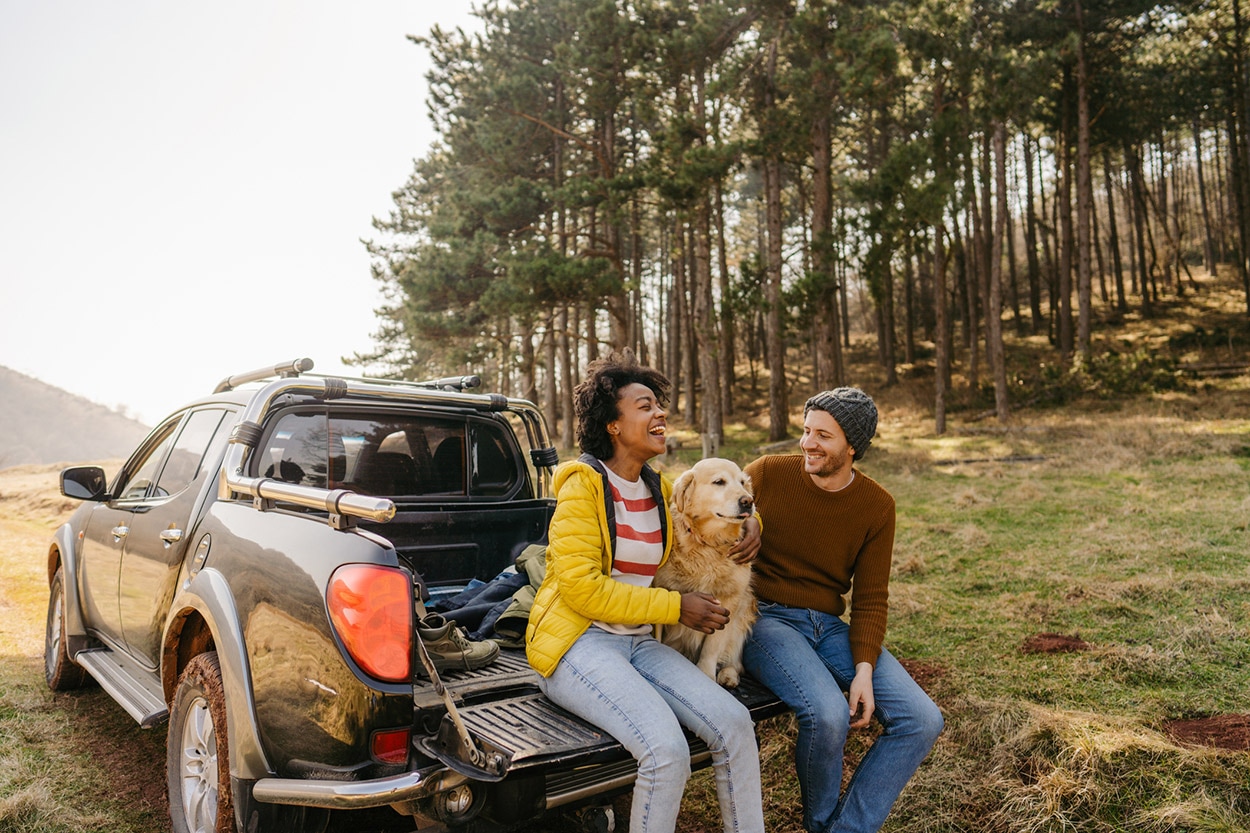How to Plan a Road Trip on a Budget
9 Min Read | Published: May 2, 2025

Planning a road trip? See how to plan a road trip on a budget, with money-saving tips like opting to camp, packing a cooler, and using the right credit card.
At-A-Glance
- Road trips can be great fun, but costs can quickly add up if you’re not mindful.
- Setting a budget is the first step to saving money on any road trip, whether you plan to go away for a week, a month, or longer.
- Camping can be a major money saver, but you don’t need to sacrifice comfort to save.
- The best credit cards for road trips offer cost-saving benefits on hotels, dining, groceries, gas, and parking.
In April 2017, my husband and I agreed it was time for a classic Great American Road Trip. We gave notice at our jobs, put our belongings in storage, ended our lease, and left New York in late May. Our arguably not-so-sound plan: Travel until we either A) found a new town to call home or B) ran out of money.
Knowing that our wanderlust made plan B the more likely possibility, our ethos was to get as much out of our road trip as possible without breaking the bank. Our three-month trip around North America was a great success – a transformative experience that, as cheesy as it may sound, proved true the adage “home is where the heart is.”
Even if you’re planning to spend only a week or two on the road, there are plenty of ways to save money. Here’s my guide to planning a road trip on a budget – and how the right credit cards can help you get rewarded for common road trip expenses.
1. Set a Road Trip Budget
Any road trip can be as lavish or bare bones as you like – and your budget supports. That’s why the first step to planning your road trip is to establish a budget. Knowing how much you can comfortably spend can help you decide on must-see destinations, plan a logical route, assess lodging options, and consider food choices. You’ll also want to factor in fuel costs, souvenirs, and unexpected expenses.
If you’re erring on the side of bare bones in hopes of spending as little as possible, now is also a good time to think about what you’re willing to sacrifice. You can save a significant amount of money on lodging costs by camping – more on lodging later – but that’s not an option for everyone. And even if camping, you’ll need to factor in gear like a reliable tent, sleeping bag, sleeping pad, and any other creature comforts you can’t do without.
2. Plan Your Road Trip Route
Pick out the places you want to visit most, map them out, and begin connecting the dots to find a logical route. Online road trip planning maps can be helpful. Be sure to consider how long you can safely spend behind the wheel. Just because you can get from point A to point B in 12 hours, should you? Here are some other route planning considerations:
What season are you traveling? Consider the time of year you plan to travel. If you’re going on a winter – or even early spring – road trip, it may be best to opt for a southern route to avoid seasonal road closures. Similar considerations are important for camping and sightseeing. It was over 100 degrees at night when I camped at the Grand Canyon in July; it was in the 20s when two of my friends camped there in February.
If camping, book early. Campsites in national parks or other popular areas can fill up quickly. My husband and I didn’t book in advance, and though we consistently got lucky with campsites, that is not a risk I’d take again. If parks are part of your plan, make reservations sooner than later and keep those dates in mind as you construct your “official” route.
Leave room for spontaneity. In my experience, shorter trips may be worth planning more intensely so you can get the most out of your time. On longer trips, however, spontaneity is key – try to leave more room for it.
For example, when planning your route, you might be tempted to book hotels in advance to try to lock in better rates. But unless you can be sure you’re going to follow your plan to a T, including arrival times, doing so might not be worth it. Longer road trips are bound to have some course corrections as you:
- Come across intriguing destinations you hadn’t planned to visit. (Have you dug Wall Drug? It’s not your typical roadside stop and shop.)
- Run into the dreaded road closure. (My bucket-list Big Sur trip proved impossible – so far! – due to landslides.)
- Decide to stay an extra day at a national park. (Pictures never do it justice.)
Speaking of national parks:
Consider an annual national parks pass. Spacious skies and amber waves of grain: America’s natural landscapes can add a breathtaking dimension to your road trip. A cost-effective way to take them in is to purchase the annual America the Beautiful National Parks and Federal Recreational Lands Pass. The pass covers entrance fees at over 2,000 federal recreation sites, including national parks, national forests, and more – and it pretty much pays for itself if you visit more than two national parks in a year.
3. Lodging Costs Add Up Quickly, but Camping Can Help
On our road trip, my husband and I kept lodging costs to a minimum by spending only 11 nights in hotels. The remaining 80 nights were mostly spent camping for free on public lands managed by the U.S. Bureau of Land Management (BLM), at free “primitive” campsites in national forests, or at campgrounds that usually cost around $20 per night. If hotels averaged $100 a night, camping likely saved us as much as $8,000.
Camping considerations. If you choose to camp, here are key considerations:
- There’s nothing worse than getting to your desired campground late at night to find out all spots are taken. If the campground is first-come, first-serve, aim to get in early – save the sightseeing for later.
- If you’re backcountry camping at national parks, national forests, or on BLM land, check for rules and regulations ahead of time. Some locations might require a permit, but they’re often free. Others might require storing food in a bear canister, for example.
- No matter where you camp, follow the Seven Principals of Leave No Trace, a doctrine created by the Leave No Trace Center for Outdoor Ethics.
Hotel considerations. Not everybody wants to rough it, and even if you don’t mind it, a hotel can be a luxurious change of pace – and needed when visiting cities. Just remember that lodging costs can vary a lot by location. To save money on your road trip, stay at hotels on the outskirts of town. They’re often more affordable and more likely to have free parking. Staying at hotels with parking fees can add unnecessary expenses.
4. Prep Your Vehicle in Advance
If you aren’t mechanically inclined, have your mechanic do a pre-trip inspection. It’s better to spot any problems now so you don’t have to deal with them later. My editor credits his mechanic as a life saver for refusing to release his car without new tires the day before he left for a road trip that ended up including a once-a-century ice storm in Asheville, North Carolina. Some additional thoughts worth considering:
- Ensure you’re up to date with insurance, registration, and inspections.
- Keep a plug or patch kit for flats, as well as a jack, a flashlight, and other small tools.
- Stock a roadside emergency kit, with first aid, jumper cables, reflective triangles, etc.
- Get a physical map as a backup if your GPS fails or you go through an area with minimal service.
Word to the wise: Even if your car is in tip top shape, it’s still important to set aside funds for unexpected expenses. We ended up with two leaky tires and a broken muffler after driving down a rough logging road on Vancouver Island, British Columbia. Repairs set us back a few hours and over 700 Canadian dollars, but charging the purchase to a no foreign transaction fee credit card helped us avoid paying more than we needed to.
Don’t forget about entertainment. Music, podcasts, audiobooks – whatever you enjoy, be sure to download and save a good chunk of content to your preferred listening device. There’s a good chance you’ll be driving through dead zones where streaming won’t cut it.
5. Keep Food Costs Down by Shopping at Grocery Stores
Road trip food costs can add up quickly if you’re buying every meal from restaurants. While you don’t want to miss out on great local food options, there are ways to help save money on food and beverages:
Keep a cooler in the back seat. Stop at grocery stores to pick up fruits and vegetables that store well, such as apples, oranges, bananas, avocados, carrots, peppers, and cherry tomatoes. Tortillas, hard cheeses, nut butters, condiments like mustard and hot sauce, and dry-cured meats also store well – even if you’re not keeping ice in the cooler 24/7. Having such items on hand makes for quick snacks, breakfasts, and light lunches.
Bring insulated water bottles. You can buy water, but you don’t have to. Instead, bring along a few reusable water bottles and refill them at rest stops and other filling stations along the way. Vacuum-insulated, stainless steel options can keep your water – or preferred hot beverage – at optimal temperatures for extended periods.
Budget for local delicacies. The stocked cooler is a smart way to save, but still leave room in your budget for local flavor. You can’t stop off at Venice Beach without hitting a taco truck or cross Louisiana’s Lake Pontchartrain Causeway without stopping for beignets and chicory coffee in New Orleans.
6. Factor in Fuel Costs and Don’t Forget About Parking
When planning your road trip, figure out how many gallons your vehicle takes, how many miles per gallon you get on average, and estimate how many miles your trip will be. Then, take a look at average gas prices around the country – gas prices can vary tremendously from state to state. This should give you a good idea of what you can expect to budget for gas.
Pay in cash or use a rewards credit card. It’s not a bad idea to keep cash on hand for times you come across gas stations that offer lower prices for cash payments. But not all gas stations charge more for debit or credit purchases. In these cases, aim to use a credit card with points or cash back rewards for gas station spending.
Don’t forget about parking costs. You might have to pay for parking in cities, and even some small towns. Many meters these days accept cards, but it’s still a good idea to keep some quarters on hand.
7. Use a Combo of Cash and Credit Cards to Optimize Savings
My ultimate tip is to use a mix of cash and credit cards. Keep some cash on hand for cash-only purchases and cheaper gas, when available. Use one or two credit cards for everything else so you can optimize the amount of rewards you earn from road trip expenses.
Some cards offer a suite of rewards that are practically tailored to a road trip. The Blue Cash Preferred® Card from American Express, for example, offers cash back on eligible grocery, gas, parking, and even streaming service spending. Combine that with a card that offers points on qualifying hotel and restaurant spending, like the American Express® Green Card, and you’ll be able to earn rewards on almost all card-based road trip transactions. Those rewards can then be redeemed toward statement credits to help reduce your statement balance, or toward future travel experiences – potentially saving you money now and in the long run. (Keep in mind that rates and fees apply to the cards mentioned above.)
The Takeaway
Ready to plan the ultimate road trip? While costs can add up quickly, a bit of financial savvy can help you save money in the long run. Choosing to camp instead of staying at hotels may be the best way to keep your budget to a minimum, but there are plenty of additional ways to cut costs, from shopping at grocery stores to using credit cards that will reward you for your road trip expenses.
SHARE
Related Articles
How to Earn a Beach Vacation with a Credit Card
When you plan your next vacation, consider paying for it with your travel credit card. Here’s how to save and earn almost-free flights and hotel stays using your points.
How to Travel Alone and Save Money
From travel insurance to budgeting, solo travelers have a lot to consider. Here are a few money-saving tips to help you plan your next solo trip.
Plan Your Next Trip With Travel Rewards Credit Cards
Dreaming about your next vacation? With a travel rewards credit card, you can plan your trip and redeem your points to cut travel costs.
The material made available for you on this website, Credit Intel, is for informational purposes only and intended for U.S. residents and is not intended to provide legal, tax or financial advice. If you have questions, please consult your own professional legal, tax and financial advisors.












